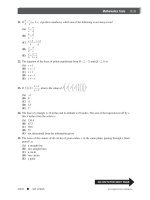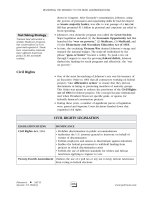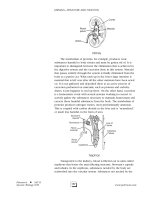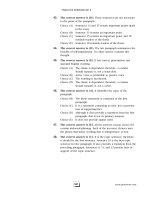New SAT Math Workbook Episode 2 part 3 pdf
Bạn đang xem bản rút gọn của tài liệu. Xem và tải ngay bản đầy đủ của tài liệu tại đây (184.5 KB, 20 trang )
Geometry
205
www.petersons.com
3. RIGHT TRIANGLES
A. Pythagorean theorem
(leg)
2
+ (leg)
2
= (hypotenuse)
2
52
25 4
29
29
22
2
2
2
() ()
=
=
=
=
+
+
x
x
x
x
B. Pythagorean triples
These are sets of numbers that satisfy the Pythagorean Theorem. When a given set of numbers such as 3, 4, 5
forms a Pythagorean triple (3
2
+ 4
2
= 5
2
), any multiples of this set such as 6, 8, 10 or 30, 40, 50 also form a
Pythagorean triple. Memorizing the sets of Pythagorean triples that follow will save you valuable time in solving
problems, for, if you recognize given numbers as multiples of Pythagorean triples, you do not have to do any
arithmetic at all. The most common Pythagorean triples that should be memorized are
3, 4, 5
5, 12, 13
8, 15, 17
7, 24, 25
Squaring 34 and 16 to apply the Pythagorean theorem would take too much time. Instead, recognize the hypot-
enuse as 2(17). Suspect an 8, 15, 17 triangle. Since the given leg is 2(8), the missing leg will be 2(15) or 30,
without any computation at all.
Chapter 13
206
www.petersons.com
C. 30°–60°–90° triangle
a) The leg opposite the 30° angle is one-half the hypotenuse.
b) The leg opposite the 60° angle is one-half the hypotenuse ·
3 .
c) An altitude in an equilateral triangle forms a 30°–60°–90° triangle and is therefore equal to one-half the
side · 3 .
D. 45°–45°–90° triangle (isosceles right triangle)
a) Each leg is one-half the hypotenuse times 2 .
b) Hypotenuse is leg times 2 .
c) The diagonal of a square forms a 45°–45°–90° triangle and is therefore equal to a side times 2 .
Geometry
207
www.petersons.com
Exercise 3
Work out each problem. Circle the letter that appears before your answer.
1. A farmer uses 140 feet of fencing to enclose a
rectangular field. If the ratio of length to width
is 3 : 4, find the diagonal, in feet, of the field.
(A) 50
(B) 100
(C) 20
(D) 10
(E) cannot be determined
2. Find the altitude of an equilateral triangle
whose side is 20.
(A) 10
(B)
20 3
(C)
10 3
(D)
20 2
(E) 10 2
3. Two boats leave the same dock at the same time,
one traveling due west at 8 miles per hour and
the other due north at 15 miles per hour. How
many miles apart are the boats after three hours?
(A) 17
(B) 69
(C) 75
(D) 51
(E) 39
4. Find the perimeter of a square whose diagonal
is
62
.
(A) 24
(B)
12 2
(C) 12
(D) 20
(E)
24 2
5. Find the length of DB.
(A) 8
(B) 10
(C) 12
(D) 15
(E) 20
Chapter 13
208
www.petersons.com
4. COORDINATE GEOMETRY
A. Distance between two points =
xx yy
21
2
21
2
− +
()()
-
The distance between (–3, 2) and (5, –1) is
−− ++3+935 8 64 73
2
2
22
()
=
() ()
==2- -1 -
B. The midpoint of a line segment =
xxyy
1212
22
++
,
Since a midpoint is in the middle, its coordinates are found by averaging the x coordinates and averaging the y
coordinates. Remember that to find the average of two numbers, you add them and divide by two. Be very careful
of signs in adding signed numbers. Review the rules given earlier if necessary.
The midpoint of the segment joining (–4, 1) to (–2, –9) is
− ++4
2
1
222
-2 -9
-6 -8
-3,-4
() ()
=
=
(
,,
))
Exercise 4
Work out each problem. Circle the letter that appears before your answer.
1. AB is the diameter of a circle whose center is
O. If the coordinates of A are (2, 6) and the
coordinates of B are (6, 2), find the coordinates
of O.
(A) (4, 4)
(B) (4, –4)
(C) (2, –2)
(D) (0, 0)
(E) (2, 2)
2. AB is the diameter of a circle whose center is
O. If the coordinates of O are (2, 1) and the
coordinates of B are (4, 6), find the coordinates
of A.
(A)
33
1
2
,
(B)
12
1
2
,
(C) (0, –4)
(D)
2
1
2
1,
(E)
−1 −,2
1
2
3. Find the distance from the point whose
coordinates are (4, 3) to the point whose
coordinates are (8, 6).
(A) 5
(B) 25
(C)
7
(D)
67
(E) 15
4. The vertices of a triangle are (2, 1), (2, 5), and
(5, 1). The area of the triangle is
(A) 12
(B) 10
(C) 8
(D) 6
(E) 5
5. The area of a circle whose center is at (0,0) is
16π. The circle passes through each of the
following points except
(A) (4, 4)
(B) (0, 4)
(C) (4, 0)
(D) (–4, 0)
(E) (0, –4)
Geometry
209
www.petersons.com
5. PARALLEL LINES
A. If two lines are parallel and cut by a transversal, the alternate interior angles are
congruent.
If
AB
is parallel to
CD
, then angle 1 ≅ angle 3 and
angle 2 ≅ angle 4.
B. If two parallel lines are cut by a transversal, the corresponding angles are congruent.
If
AB
is parallel to
CD
, then angle 1 ≅ angle 5
angle 2 ≅ angle 6
angle 3 ≅ angle 7
angle 4 ≅ angle 8
C. If two parallel lines are cut by a transversal, interior angles on the same side of the
transversal are supplementary.
If
AB
is parallel to
CD
, angle 1 + angle 4 = 180°
angle 2 + angle 3 = 180°
Chapter 13
210
www.petersons.com
Exercise 5
Work out each problem. Circle the letter that appears before your answer.
1. If
AB
is parallel to
CD
,
BC
is parallel to
ED
,
and angle B = 30°, find the number of degrees
in angle D.
(A) 30
(B) 60
(C) 150
(D) 120
(E) none of these
2. If
AB
is parallel to
CD
, angle A = 35°, and
angle C = 45°, find the number of degrees in
angle AEC.
(A) 35
(B) 45
(C) 70
(D) 80
(E) 100
3. If
AB
is parallel to
CD
and angle 1 = 130°,
find angle 2.
(A) 130°
(B) 100°
(C) 40°
(D) 60°
(E) 50°
4. If
AB
is parallel to
CD EF,
bisects angle BEG,
and
GF
bisects angle EGD, find the number of
degrees in angle EFG.
(A) 40
(B) 60
(C) 90
(D) 120
(E) cannot be determined
5. If
AB
is parallel to
CD
and angle 1 = x
°
, then
the sum of angle 1 and angle 2 is
(A) 2x
°
(B) (180 – x)°
(C) 180°
(D) (180 + x)°
(E) none of these
Geometry
211
www.petersons.com
6. TRIANGLES
A. If two sides of a triangle are congruent, the angles opposite these sides are congruent.
If
AB AC≅
, then angle B ≅ angle C.
B. If two angles of a triangle are congruent, the sides opposite these angles are congruent.
If angle S ≅ angle T, then
RS RT≅
.
C. The sum of the measures of the angles of a triangle is 180°.
Angle F = 180º – 100º – 30º = 50º.
Chapter 13
212
www.petersons.com
D. The measure of an exterior angle of a triangle is equal to the sum of the measures of
the two remote interior angles.
Angle 1 = 140°
E. If two angles of one triangle are congruent to two angles of a second triangle, the
third angles are congruent.
Angle A will be congruent to angle R.
Geometry
213
www.petersons.com
Exercise 6
Work out each problem. Circle the letter that appears before your answer.
1. The angles of a triangle are in the ratio 1 : 5 : 6.
This triangle is
(A) acute
(B) obtuse
(C) isosceles
(D) right
(E) equilateral
2. If the vertex angle of an isosceles triangle is
50°, find the number of degrees in one of the
base angles.
(A) 50
(B) 130
(C) 60
(D) 65
(E) 55
3. In triangle ABC, angle A is three times as large
as angle B. The exterior angle at C is 100°.
Find the number of degrees in angle A.
(A) 60
(B) 80
(C) 20
(D) 25
(E) 75
4. If a base angle of an isosceles triangle is
represented by x
°
, represent the number of
degrees in the vertex angle.
(A) 180 – x
(B) x – 180
(C) 2x – 180
(D) 180 – 2x
(E) 90 – 2x
5. In triangle ABC,
AB BC=
. If angle A =
(4x – 30)° and angle C = (2x + 10)°, find the
number of degrees in angle B.
(A) 20
(B) 40
(C) 50
(D) 100
(E) 80
Chapter 13
214
www.petersons.com
7. POLYGONS
A. The sum of the measures of the angles of a polygon of n sides is (n – 2)180°.
Since ABCDE has 5 sides, angle A + angle B + angle C + angle D + angle E = (5 – 2)180° = 3(180)° = 540°
B. Properties of a parallelogram
a) Opposite sides are parallel
b) Opposite sides are congruent
c) Opposite angles are congruent
d) Consecutive angles are supplementary
e) Diagonals bisect each other
C. Properties of a rectangle
a) All 5 properties of a parallelogram
b) All angles are right angles
c) Diagonals are congruent
D. Properties of a rhombus
a) All 5 properties of a parallelogram
b) All sides are congruent
c) Diagonals are perpendicular to each other
d) Diagonals bisect the angles
E. Properties of a square
a) All 5 parallelogram properties
b) Two additional rectangle properties
c) Three additional rhombus properties
Geometry
215
www.petersons.com
Exercise 7
Work out each problem. Circle the letter that appears before your answer.
1. Find the number of degrees in the sum of the
interior angles of a hexagon.
(A) 360
(B) 540
(C) 720
(D) 900
(E) 1080
2. In parallelogram ABCD, AB = x + 4, BC = x –
6, and CD = 2x – 16. Find AD.
(A) 20
(B) 24
(C) 28
(D) 14
(E) 10
3. In parallelogram ABCD, AB = x + 8, BC = 3x,
and CD = 4x – 4. ABCD must be a
(A) rectangle
(B) rhombus
(C) trapezoid
(D) square
(E) pentagon
4. The sum of the angles in a rhombus is
(A) 180°
(B) 360°
(C) 540°
(D) 720°
(E) 450°
5. Which of the following statements is false?
(A) A square is a rhombus.
(B) A rhombus is a parallelogram.
(C) A rectangle is a rhombus.
(D) A rectangle is a parallelogram.
(E) A square is a rectangle.
Chapter 13
216
www.petersons.com
8. CIRCLES
A. A central angle is equal in degrees to its intercepted arc.
If arc AB = 50°, then angle AOB = 50°.
B. An inscribed angle is equal in degrees to one-half its intercepted arc.
If arc AC = 100°, then angle ABC = 50°.
C. An angle formed by two chords intersecting in a circle is equal in degrees to
one-half the sum of its intercepted arcs.
If arc AD = 30° and arc CB = 120°, then angle AED = 75°.
D. An angle outside the circle formed by two secants, a secant and a tangent, or two
tangents is equal in degrees to one-half the difference of its intercepted arcs.
If arc AD = 120° and arc BD = 30°, then angle C = 45°.
E. Two tangent segments drawn to a circle from the same external point are congruent.
If
AC
and
AE
are tangent to circle O at B and D, then AB ≅ AD.
Geometry
217
www.petersons.com
Exercise 8
Work out each problem. Circle the letter that appears before your answer.
1. If circle O is inscribed in triangle ABC, find the
length of side AB.
(A) 12
(B) 14
(C) 9
(D) 10
(E) 7
2. Find angle x.
(A) 40°
(B) 20°
(C) 50°
(D) 70°
(E) 80°
3. Find angle x.
(A) 120°
(B) 50°
(C) 70°
(D) 40°
(E) 60°
4. Find the number of degrees in arc AC.
(A) 60
(B) 50
(C) 25
(D) 100
(E) 20
5. The number of degrees in angle ABC is
(A)
1
2
y
(B) y
(C)
1
2
x
(D)
1
2
xy−
()
(E)
1
2
xy+
()
Chapter 13
218
www.petersons.com
9. VOLUMES
A. The volume of a rectangular solid is equal to the product of its length, width, and height.
V = (10)(6)(5) = 300
B. The volume of a cube is equal to the cube of an edge, since the length, width, and
height are all equal.
V = (3)
3
= 27
C. The volume of a cylinder is equal to π times the square of the radius of the base
times the height.
V = π (4)
2
(5) = 80π
Geometry
219
www.petersons.com
Exercise 9
Work out each problem. Circle the letter that appears before your answer.
4. A rectangular tank 10 inches by 8 inches by 4
inches is filled with water. If the water is to be
transferred to smaller tanks in the form of
cubes 4 inches on a side, how many of these
tanks are needed?
(A) 4
(B) 5
(C) 6
(D) 7
(E) 8
5. The base of a rectangular tank is 6 feet by 5
feet and its height is 16 inches. Find the
number of cubic feet of water in the tank when
it is
5
8
full.
(A) 25
(B) 40
(C) 480
(D) 768
(E) 300
1. The surface area of a cube is 96 square feet.
How many cubic feet are there in the volume of
the cube?
(A) 16
(B) 4
(C) 12
(D) 64
(E) 32
2. A cylindrical pail has a radius of 7 inches and a
height of 10 inches. Approximately how many
gallons will the pail hold if there are 231 cubic
inches to a gallon? (Use π =
22
7
)
(A) .9
(B) 4.2
(C) 6.7
(D) 5.1
(E) 4.8
3. Water is poured into a cylindrical tank at the
rate of 9 cubic inches a minute. How many
minutes will it take to fill the tank if its
radius is 3 inches and its height is 14 inches?
(Use π =
22
7
)
(A) 14
2
3
(B) 44
(C) 30
(D) 27
2
9
(E) 35
Chapter 13
220
www.petersons.com
10. SIMILAR POLYGONS
A. Corresponding angles of similar polygons are congruent.
B. Corresponding sides of similar polygons are in proportion.
If triangle ABC is similar to triangle DEF and the sides and angles are given as marked, then EF must be equal to
12 as the ratio of corresponding sides is 2 : 6 or 1 : 3.
C. When figures are similar, all ratios between corresponding lines are equal. This
includes the ratios of corresponding sides, medians, altitudes, angle bisectors, radii,
diameters, perimeters, and circumferences. The ratio is referred to as the linear ratio
or ratio of similitude.
If triangle ABC is similar to triangle DEF and the segments are given as marked, then EH is equal to 2.5
because the linear ratio is 6 : 3 or 2 : 1.
D. When figures are similar, the ratio of their areas is equal to the square of the linear ratio.
If triangle ABC is similar to triangle DEF, the area of triangle ABC will be 9 times as great as the area of
triangle DEF. The linear ratio is 12 : 4 or 3 : 1. The area ratio will be the square of this or 9 : 1. If the area of
triangle ABC had been given as 27, the area of triangle DEF would be 3.
Geometry
221
www.petersons.com
E. When figures are similar, the ratio of their volumes is equal to the cube of their
linear ratio.
The volume of the larger cube is 8 times the volume of the smaller cube. The ratio of sides is 4 : 2 or 2 : 1. The
ratio of areas would be 4 : 1. The ratio of volumes would be 8 : 1.
Exercise 10
Work out each problem. Circle the letter that appears before your answer.
1. If the area of a circle of radius x is 5π, find the
area of a circle of radius 3x.
(A) 10π
(B) 15π
(C) 20π
(D) 30π
(E) 45π
2. If the length and width of a rectangle are each
doubled, the area is increased by
(A) 50%
(B) 100%
(C) 200%
(D) 300%
(E) 400%
3. The area of one circle is 9 times as great as the
area of another. If the radius of the smaller
circle is 3, find the radius of the larger circle.
(A) 9
(B) 12
(C) 18
(D) 24
(E) 27
4. If the radius of a circle is doubled, then
(A) the circumference and area are both
doubled
(B) the circumference is doubled and the area
is multiplied by 4
(C) the circumference is multiplied by 4 and
the area is doubled
(D) the circumference and area are each
multiplied by 4
(E) the circumference stays the same and the
area is doubled
5. The volumes of two similar solids are 250 and
128. If a dimension of the larger solid is 25,
find the corresponding side of the smaller solid.
(A) 12.8
(B) 15
(C) 20
(D) 40
(E) cannot be determined
Chapter 13
222
www.petersons.com
RETEST
Work out each problem. Circle the letter that appears before your answer.
1. The area of a trapezoid whose bases are 10 and
12 and whose altitude is 3 is
(A) 66
(B) 11
(C) 33
(D) 25
(E) 16
1
2
2. The circumference of a circle whose area is
16π is
(A) 8π
(B) 4π
(C) 16π
(D) 8
(E) 16
3. Find the perimeter of a square whose diagonal
is 8.
(A) 32
(B) 16
(C)
32 2
(D) 16 2
(E) 32 3
4. The length of the line segment joining the point
A(4, –3) to B(7, –7) is
(A)
221
(B)
185
(C) 7
(D) 6
1
2
(E) 5
5. Find angle x if
AB
is parallel to
CD
.
(A) 35°
(B) 80°
(C) 245°
(D) 65°
(E) 55°
6. In triangle ABC, the angles are in a ratio of
1 : 1 : 2. The largest angle of the triangle is
(A) 45°
(B) 60°
(C) 90°
(D) 120°
(E) 100°
7. Find the number of degrees in each angle of a
regular pentagon.
(A) 72
(B) 108
(C) 60
(D) 180
(E) 120
8. Find the number of degrees in arc AB.
(A) 80
(B) 20
(C) 60
(D) 100
(E) 90
9. Find the edge, in inches, of a cube whose
volume is equal to the volume of a rectangular
solid 2 in. by 6 in. by 18 in.
(A) 4
(B) 8
(C) 5
(D) 6
(E) 7
10. If the volume of one cube is 8 times as great as
another, then the ratio of the area of a face of
the larger cube to the area of a face of the
smaller cube is
(A) 2 : 1
(B) 4 : 1
(C)
21:
(D) 8 : 1
(E)
221:
Geometry
223
www.petersons.com
SOLUTIONS TO PRACTICE EXERCISES
Diagnostic Test
1. (A) Represent the angles as 5x, 6x, and 7x.
They must add up to 180°.
18 180
10
x
x
=
=
The angles are 50°, 60°, and 70°, an acute
triangle.
2. (B) The area of a circle is πr
2
. The area of a
circle with radius x is πx
2
, which equals 4.
The area of a circle with radius 3x is π (3x)
2
= 9πx
2
= 9 · 4 = 36.
3. (D)
23
49
13
13
22 2
2
2
+
+
=
=
=
=
x
x
x
x
4. (E)
The sum of the angles in a parallelogram is 360°.
12 360
30
x
x
=°
=°
Angle B = 5x = 5 · 30° = 150°
5. (A) The volume of a rectangular box is the
product of its length, width, and height. Since
the height is 18 inches, or 1
1
2
feet, and the
length and width of the square base are the
same, we have
xx
x
x
⋅⋅ =
=
=
1
1
2
24
16
4
2
6. (D) The remaining degrees of the triangle are
180 – x. Since the triangle is isosceles, the
remaining angles are equal, each
180
2
90
2
−
−
xx
=
.
7. (D)
Angle ABX = 90° – 37° = 53°
Angle ABY = 180° – 53° = 127°
8. (C)
Extend
FE
to H. ∠EHG = ∠AFE = 40°.
∠HEG must equal 110° because there are 180°
in a triangle. Since ∠FEG is the supplement of
∠HEG, ∠FEG = 70°.
9. (C)
Angle O is a central angle equal to its arc, 100°.
This leaves 80° for the other two angles. Since the
triangle is isosceles (because the legs are both
radii and therefore equal), angle ABO is 40°.
10. (A)
d =
()
()
()
=
() ( )
=
==
551
86 6436
100 10
2
2
22
− 3+
++
-
Chapter 13
224
www.petersons.com
Exercise 1
1. (C) Find the area in square feet and then
convert to square yards by dividing by 9.
Remember there are 9 square feet in one square
yard.
(18 · 20) ÷ 9 = 360 ÷ 9 = 40 square yards
2. (B) Area of parallelogram = b · h
xx
x
x
x
x
+
+
7715
49 15
64
8
715
2
2
()()
=
=
=
=
==
−
−
Base
3. (B) Area of triangle =
1
2
⋅⋅bh
Using one leg as base and the other as altitude,
the area is
1
2
· 6 · 8 = 24. Using the hypotenuse
as base and the altitude to the hypotenuse will
give the same area.
1
2
10 24
524
48
1
2
10 4 8 24
⋅⋅ =
=
= ∴⋅ ⋅ =
h
h
h
4. (E) Area of rhombus =
1
2
· product of
diagonals
Area =
()()
=
()
=
1
2
46
1
2
24 12
22
xx x x
5. (C)
radius of circle = 3
Area = πr
2
= 9π
Exercise 2
1. (A) Area of equilateral triangle =
s
2
4
3
Therefore,
s
2
4
must equal 16
s
2
= 64
s = 8
Perimeter is 8 + 8 + 8 = 24
2. (B) In 4 hours the hour hand moves through
one-third of the circumference of the clock.
Cr==
()
=
⋅ =
2236
1
3
62
ππ π
ππ
3. (D) Compare 2πr with 2π (r + 3).
2π (r + 3) = 2πr + 6π
Circumference was increased by 6π. Trying
this with a numerical value for r will give the
same result.
4. (E) In one revolution, the distance covered is
equal to the circumference.
C = 2πr = 2π (18) = 36π inches
To change this to feet, divide by 12.
36
12
3
π
π
= feet
In 20 revolutions, the wheel will cover 20(3π)
or 60π feet.
5. (D) Area of rectangle = b · h = 36
Area of square = s
2
= 36
Therefore, s = 6 and perimeter = 24
